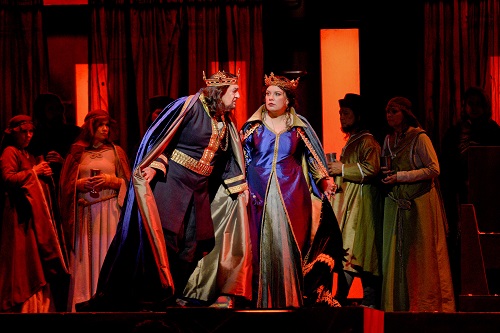 United States Verdi, Macbeth: Soloists, Chorus, and Orchestra of LA Opera / James Conlon (conductor), Dorothy Chandler Pavilion, Los Angeles, 22.9.2016. (JRo)
United States Verdi, Macbeth: Soloists, Chorus, and Orchestra of LA Opera / James Conlon (conductor), Dorothy Chandler Pavilion, Los Angeles, 22.9.2016. (JRo)

Verdi, Macbeth
Cast:
Macbeth – Plácido Domingo
Lady Macbeth – Ekaterina Semenchuk
Banquo – Roberto Tagliavini
Macduff – Arturo Chacón-Cruz
Malcolm – Josh Wheeker
Lady-in-Waiting – Summer Hassan
Doctor/First Apparition – Theo Hoffman
Second Apparition – Liv Redpath
Third Apparition – Isaiah Morgan
Production:
Director/Co-Set Designer – Darko Tresnjak
Co-Set Designer – Colin McGurk
Costume Design – Suttirat Anne Larlarb
Lighting Design – Matthew Richards
Projection Design – Sean Nieuwenhuis
Chorus Director – Grant Gershon
Macbeth, interpreted by a consummate conductor and orchestra with magnificent singing from the chorus and principals, made for a powerful night of opera and a brilliant opener to LA Opera’s 2016-17 season.
With a narrative rife with the evil machinations of that tortured pair of king-slayers, Lord and Lady Macbeth, Verdi gave us his first Shakespearean opera and a path forward in the evolution of the art form. Singers at the service of the drama rather than the bel canto notion of showcasing the individual voice was a dramatic and musical breakthrough for Verdi and for mid-nineteenth century opera. Along with the later Otello and Falstaff, Verdi created a trio of riveting operas inspired by his abiding love for Shakespeare, his favorite poet and dramatist.
LA Opera’s favorite tenor turned baritone, Plácido Domingo, graced and commanded the stage, inhabiting the role of Macbeth with superb singing and an uncanny ability to portray a man in his prime, intent on the crown no matter what the cost. Much has been made of Domingo’s transformation into baritone roles and of his stamina at the age of 75. With ease, he traversed, both musically and dramatically, the landscape of Macbeth’s psyche from virile nobleman greedy for power to tormented murderer, aging before our eyes as he sinks deeper into the mire of his misdeeds.
By his side, riding the wave of blood lust, was the Russian mezzo-soprano, Ekaterina Semenchuk. Endowed with a wide range, she sang the soprano role of Lady Macbeth with expressive power, chilling in her single-minded determination to put her husband on the throne of Scotland. Though there is no place for romantic love in Macbeth, there is the sensuality of desire – a desire for dominion that pervaded every aria sung by the couple, whether alone or together. Semenchuk simmered with ambition, culminating in her lascivious embrace of the throne as she sang ‘La luce langue’.
The compelling Domingo and Semenchuk were supported by a strong cast. Roberto Tagliavini, with his plush bass, sang Banquo’s two arias with sympathetic fervor. Arturo Chacón-Cruz, a strong lyric tenor, gave voice to Macduff, who ultimately murders Macbeth, in Verdi’s beautifully written aria of Act IV.
Darko Tresnjak, director and set designer (with Colin McGurk), was responsible for some excellent choices and some unfortunate ones. On the positive side, the decision to push the modernist castle façade to the front of the stage, placing the singers closer to the audience, contributed to a feeling of claustrophobic dread and rendered both voice and drama all the more potent. A second story walkway atop the façade gave the witches’ chorus a clever platform from which to sing, gesticulate, and posture.
But as the evening wore on, and especially in Acts III and IV, the negative choices mounted. As members of the coven of witches, rat-tailed devils pranced and preened about the stage, growing tiresome and overly sexualized, contributing to a sense that the director felt he needed to inject some attention-grabbing antics to please the audience. Three giant Technicolor heads, looking like cheesy porcelain beer mugs, appeared, supported by the bodies of three devils with only their legs visible. What should have been ghostly apparitions representing the witches’ prophesies – a helmeted head, a bloodied child, and a child with a crown – looked like refugees from a 1950s television commercial of dancing cigarette packs. Conjured up by the witches to answer Macbeth’s ‘Shall Banquo’s issue reign in this kingdom’, the silent parade of eight kings utilized similar beer mug heads like a bizarre Radio City Musical Hall number for the Rockettes and made a near mockery of Macbeth’s tragic Act III aria. In Verdi’s own words, ‘The kings must not be puppets, but eight men of flesh and blood’. So much for the composer’s intentions.
In Shakespeare’s plot the witches tell Macbeth he ‘shall never vanquished be until Great Birnham wood to high Dunsinane hill shall come against him’. I longed for the Birnham wood to come alive on stage. Instead a single, anemic evergreen branch was swung back and forth by Fleanzio, Banquo’s son. But perhaps the most problematic decision was to begin Lady Macbeth’s powerful sleepwalking scene on the upper floor. She raced across the top, down the stairs, and through the first floor of the castle. An intimate, pivotal moment in the drama became remote and less spellbinding than it should have been.
Nevertheless, this was a night to revel in the power of song. The orchestra under James Conlon was sublime. And when the excellent LA Opera chorus, along with the soloists, sang the Act I, Scene II finale, the force of Verdi’s genius broke like a wave over the audience, thrilling to the core.
Jane Rosenberg